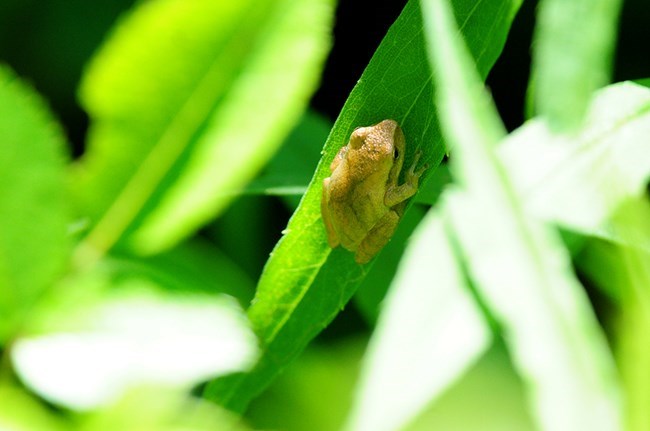Last updated: March 29, 2018
Article
The Sounds of Spring

NPS
Spring is in the air! You know spring has sprung when . . .
-
wildflowers carpet the hills with color.
-
windows are opened to let in fresh air.
-
snow melts, and streams swell with water.
-
T-shirts replace woolen sweaters.
Spring also brings new sounds, like bird songs at dawn, frog croaks by ponds, and dripping icicles. When the weather warms, the sounds you hear in national parks reflect this seasonal change. They contribute to the unique soundscape of these special places, and are among the resources that the National Park Service protects. What sounds do you associate with spring? The following profiles highlight some of the sounds visitors might hear in national parks in spring.

Damon Joyce / NPS
Yosemite National Park, California
The base of a waterfall is one place where the power of nature can be heard and also felt. Yosemite Falls in Yosemite National Park is among the world’s famous waterfalls, and the tallest in North America. Come late spring, its reputation, like its waters, significantly swells. As upper Yosemite Creek fills with snowpack melt, its waters steadily gather momentum. The sounds it makes along the way change from treble-pitched, watershed trickles to surging roars when approximately 2,400 gallons of water per second reach the cliffs and dramatically cascade in three successive drops for a total plummet of 2,425 feet. This phenomenon not only treats park visitors to spectacular views, but also to thundering sounds. Yosemite Falls is one of many waterfalls in the park. Each has a different sound signature related to the geological processes that formed it.
- Visit Yosemite National Park: https://www.nps.gov/yose/index.htm
- Enjoy this video of Yosemite Falls: https://www.nps.gov/media/video/view.htm?id=F9F47C55-9AEF-F85D-56530EA405E602C1
- Learn about Yosemite’s waterfalls: https://www.nps.gov/yose/planyourvisit/waterfalls.htm
- Learn about the science of hydrology in Yellowstone: https://www.nps.gov/yose/learn/nature/hydrology.htm
- Learn about “frazil” ice, slushy flows of thawing snow and ice in Yosemite Creek: https://www.nps.gov/media/video/view.htm?id=02C7187C-1DD8-B71B-0BEC396B2D997904
- Boreal Chorus Frogs at Yellowstone in spring: https://www.nps.gov/yell/learn/photosmultimedia/minute_chorusfrogs.htm

NPS
Cuyahoga Valley National Park, Ohio
On spring evenings along the Ohio & Erie Canal Towpath Trail at Beaver Marsh in Cuyahoga Valley National Park, the air fills with the high-pitched, “peeping” sounds of male spring peepers. Although typically hidden from view among shore grasses, the small frogs loudly announce themselves in search of mates. Visitors can enjoy the dusk chorus while strolling on the marsh boardwalk, and perhaps hear the occasional splash of a turtle, muskrat or otter from among the lily pads.
Peepers can also be heard along the banks of seasonal “vernal pools,” shallow water pools located on the east side of Brandywine Creek. The vernal waters serve as nurseries for frog eggs and growing tadpoles. Amphibians are among the many aquatic animals, insects, and plants that have adapted to live in this wetland ecosystem. Once an automobile junkyard, the restored marsh now teams with life throughout the year.
- Visit Cuyahoga National Park: https://www.nps.gov/cuva/index.htm
- Learn more about the unique ecosystem of Beaver Marsh: https://www.nps.gov/cuva/planyourvisit/the-beaver-marsh.htm
- Learn why amphibians are an important part of the ecological balance in wetland habitat at Cuyahoga NP: https://www.nps.gov/cuva/learn/nature/amphibians.htm
- Listen to the sounds of spring peepers and pickerel frogs in Cuyahoga NP: https://www.youtube.com/watch?v=tN9vWd0aJPw
- Check out this video on spring peepers recorded in Theodore Roosevelt Island National Park: https://www.nps.gov/media/video/view.htm?id=9F9FA430-1DD8-B71C-07E5280AB8655CF9

NPS
Voyageurs National Park, Minnesota
Melting ice can emit a surprising variety of sounds. From the steady drip of sun-warmed icicles to the groans and cracks of thawing lakes, ice sounds are interesting! Nestled in dense, boreal forest in northern Minnesota and spanning more than 218,000 acres along the U.S.-Canada border, Voyageurs National Park is a checkerboard of waterways that includes streams, ponds, rivers, and four major lakes: Rainy, Kabetogama, Namakan, and Sand Point Lakes. As layers of ice melt and shift with spring thaws, these water bodies awake from their winter state with new sounds of life.
The call of the loon, Minnesota’s state bird, is among the sounds that signal spring. Loons and cormorants are two species of water birds that return to the lakes each spring to mate and nest. They can be commonly found diving for fish in deep lake waters. Other birds at Voyageurs that bring the season to life include grebes, eagles, owls, flickers, and many songbirds. Wolves, beavers, moose, and frogs are other animals you might hear in spring.
- Visit Voyageurs National Park: https://www.nps.gov/voya/index.htm
- Learn about loons in Voyageurs NP: https://www.nps.gov/voya/learn/nature/common-loon.htm
- Listen to loons: https://www.allaboutbirds.org/guide/Common_Loon/sounds
- Learn about cormorants in Voyageurs NP: https://www.nps.gov/voya/learn/nature/double-crested-cormorants.htm
- Listen to cormorants: https://www.allaboutbirds.org/guide/Great_Cormorant/sounds
- Video of a beaver building his home in Voyageurs: https://www.facebook.com/VoyageursNPS/videos/1137662022913379/
- Beaver Ecology Project: https://www.nps.gov/voya/learn/nature/beaver-ecology-project.htm

NPS
Zion National Park, Utah and Bryce Canyon National Park, Utah
Like rushing spring waters, spring winds can also be a powerful force. The rock formations of Zion and Bryce Canyon National Parks were carved over time by wind and water. As wind encircles hoodoos and sweeps through the curved, sculpted walls of slot canyons, it produces a range of sounds, from whistling howls to whispering tones. And on a still day, park visitors can experience yet a different sound environment. The hard surfaces of canyon walls create ideal conditions for echoing sounds. In a slot canyon, even the slightest sounds echo and magnify, from scuttling desert lizards to nesting owls to river water flowing through the narrow canyon walls. Park visitors’ voices carry, too. Listen carefully, and nature’s subtler sounds will reveal themselves.
- Visit Zion National Park: https://www.nps.gov/zion/index.htm
- Visit Bryce National Park: https://www.nps.gov/brca/index.htm
- Learn about The Narrows at Zion: https://www.nps.gov/zion/planyourvisit/thenarrows.htm
- Listen to bird calls in Bryce Canyon National Park:
- Learn about the geology of fins (narrow walls of rock) and slot canyons in Bryce Canyon: https://www.nps.gov/brca/learn/nature/wallandnarrows.htm
- Learn about how hoodoos are formed in Bryce Canyon: https://www.nps.gov/brca/learn/nature/hoodoos.htm

Patrick Myers / NPS
Great Sand Dunes National Park, Colorado
In late spring in Great Sand Dunes National Park, melting snows flow through Medano Creek. During this time, park visitors can hear a freshwater phenomenon that only occurs in a few other places around the world: the sound of surge flow, where dunes produce their own ebb and flow. As snow waters and wind erode the dunes, sand deposits form. When rushing creek water meets these dams, it washes over and under the forms, creating underwater sand ridges. This process produces rhythmic waves, some as high as one foot! Their lapping sounds are characteristic of spring. Spring in the dunes can bring variable temperature conditions, including winds and snow. But on warmer days, park visitors can enjoy playing in the waves as they would at any beach.
The sound of sandhill cranes also heralds spring at the park. During their migration north from New Mexico, they are drawn to roost in park grasslands, and in the adjacent farm fields of San Luis Valley, which become flooded with spring waters. More than 20,000 cranes flock to these fertile, freshwater wetlands to fatten on barley grains and aquatic invertebrates, and find mates before continuing their journey to the northern U.S. and Canada. Spring at Great Sand Dunes is synonymous with their return and, thus, their calls, which fill the air with a peculiar blend of high-pitched purrs, ratcheting honks, and low moans. Most of the cranes gather in remote areas of the park not accessible to park visitors, but they can often be seen (and heard) in flight overhead, and in adjacent farm fields. If you do see the birds, the NPS reminds you to keep a respectful distance while enjoying the experience. Learn more from the NPS Watching Wildlife website.
- Visit Great Sand Dunes National Park: https://www.nps.gov/grsa/index.htm
- Learn about surge flow at Medano Creek: https://www.nps.gov/media/video/view.htm?id=A49C9498-1DD8-B71B-0B58703F391773D4
- Learn about the hydrology at Great Sand Dunes: https://www.nps.gov/grsa/learn/nature/hydrology.htm
- Learn about the migration of sand cranes to Great Sand Dunes: https://www.nps.gov/grsa/planyourvisit/sandhill-crane-migration.htm
- Listen to sandhill cranes: https://www.nps.gov/subjects/sound/sounds-sandhill-crane.htm
- Hear dunes “sing” at Great Sand Dunes: https://www.nps.gov/articles/grsa-singing-sands.htm
Sound Galleries

NPS
Enjoy a range of other sounds recorded in national parks:
- Natural Sounds and Night Skies Division Sound Gallery: https://www.nps.gov/subjects/sound/gallery.htm
- Learn about the work of the Natural Sounds and Night Skies Division in protecting park soundscape environments: https://www.nps.gov/subjects/sound/index.htm
- Rocky Mountain National Park Sound Library: https://www.nps.gov/romo/learn/photosmultimedia/soundlibrary.htm#__topdoc__
- Yellowstone National Park Sound Library: https://www.nps.gov/yell/learn/photosmultimedia/soundlibrary.htm
- Sounds of the Parks, a sound library provided by the Sound and Light Ecology Team at Colorado State University, an NPS partner: http://www.soundandlightecologyteam.colostate.edu/recordings.html
Tags
- bryce canyon national park
- cuyahoga valley national park
- great basin national park
- voyageurs national park
- yosemite national park
- zion national park
- natural sounds
- natural sounds and night skies division
- yosemite national park
- yosemite falls
- cuyahoga valley national park
- voyageurs national park
- zion national park
- bryce canyon national park
- national park service
- great sand dunes national park
- nps
- nsnsd
- spring 2018
- spring
- sounds
- sound
- biodiversity
- birds
- hydrology
- water
- great sand dunes national park and preserve
- beginnings
- new beginnings
- march
- spring equinox
- explore nature
- find your park
- first day of spring
